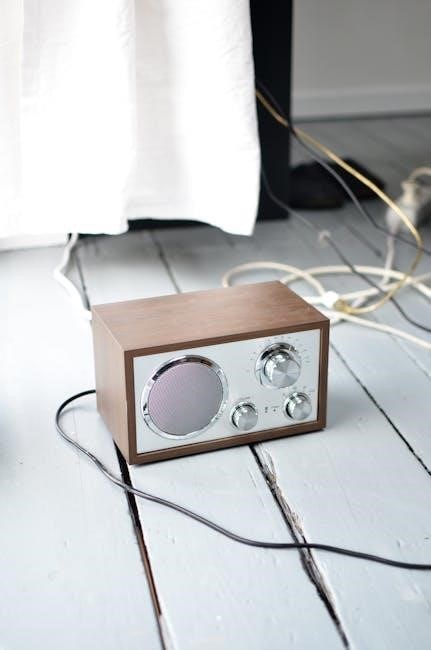A 4-way switch wiring diagram is essential for controlling lights from multiple locations, providing clear visual guidance for safe and accurate electrical connections in DIY projects.
1.1 What is a 4-Way Switch?
A 4-way switch is an electrical device used to control lighting from multiple locations. It operates by using traveler wires to complete or break circuits between switches. Unlike 2-way or 3-way switches, a 4-way switch allows for more flexibility in controlling lights from three or more locations. It is commonly installed in hallways, staircases, or large rooms where multiple control points are needed. The switch features four terminals, enabling connections for traveler wires that pass current between switches. This setup ensures smooth operation of lights from different locations, making it a versatile solution for complex lighting systems.
1.2 Importance of Wiring Diagrams for 4-Way Switches
Wiring diagrams are crucial for installing 4-way switches, as they provide a clear visual guide for connecting wires correctly. These diagrams help prevent errors, ensuring safe and functional electrical connections. They detail terminal functions, wire colors, and proper circuit configurations, making complex setups manageable for DIY enthusiasts. By following a wiring diagram, one can avoid short circuits and ensure all lights operate smoothly from multiple control points. Diagrams also simplify troubleshooting, allowing users to identify and fix issues quickly. Overall, wiring diagrams are essential for a successful and safe 4-way switch installation, especially in multi-location lighting systems.
1.3 Brief Overview of 4-Way Switch Applications
4-way switches are commonly used in lighting systems requiring control from multiple locations, such as staircases, hallways, and large rooms. They allow users to operate lights from several points, enhancing convenience and flexibility. These switches are ideal for installations involving more than two control points, making them a practical solution for modern smart home setups. They can also integrate with dimmers and LED systems, offering advanced lighting control options. By enabling seamless control from various positions, 4-way switches provide efficient and versatile lighting management solutions for both residential and commercial spaces.

Understanding the Components of a 4-Way Switch
A 4-way switch includes terminals for connecting traveler and common wires, enabling control of lights from multiple locations. It differs from 2-way and 3-way switches by allowing more control points in a circuit.
2.1 Terminals and Their Functions
A 4-way switch typically features four terminals, though some may have six for more complex configurations. The terminals are designed to connect traveler wires, which carry the electrical signal between switches. The common terminal is used to connect the incoming and outgoing wires, while the traveler terminals facilitate communication between multiple switches. Each terminal plays a critical role in ensuring the switch operates correctly, enabling control of lights from multiple locations. Proper identification and connection of these terminals are essential for safe and effective wiring.
2.2 Types of Wires Used in 4-Way Switches
In a 4-way switch setup, several types of wires are utilized to ensure proper functionality. Traveler wires, typically 3-conductor or 4-conductor cables, are used to connect between switches, enabling control from multiple locations. The common wire serves as the primary connection point, while the neutral wire completes the circuit. It’s crucial to use the correct wire gauge to prevent overheating and ensure efficiency. Consulting a wiring diagram PDF can provide a clear visual representation of these connections, aiding in accurate installation and troubleshooting. Accurate connections are vital for reliable operation.
2.3 Differences Between 2-Way, 3-Way, and 4-Way Switches
A 2-way switch controls a single light from one location, with two terminals for hot and load wires. A 3-way switch enables control from two locations, featuring three terminals: common, traveler, and load. The 4-way switch adds flexibility for control from three or more locations, using four terminals to connect traveler wires between 3-way switches. Unlike 2-way switches, 3-way and 4-way switches don’t directly connect to the power source but function within multi-switch circuits. Understanding these differences is essential for selecting the right switch for your wiring needs, as outlined in a 4-way switch wiring diagram PDF.

Safety Precautions for Wiring a 4-Way Switch
Always turn off the power and verify it with a voltage tester. Use insulated tools and safety gloves; Work in a dry, well-lit area, avoiding wet conditions. Keep loose clothing tied back and avoid jewelry. Ensure the workspace is clean and free from clutter. Never touch bare wires or terminals. Follow the wiring diagram carefully to prevent incorrect connections. If unsure, consult a licensed electrician to ensure safe installation, as detailed in a 4-way switch wiring diagram PDF.
3.1 Essential Safety Tools and Equipment
When working with a 4-way switch wiring diagram, essential safety tools include a voltage tester, insulated screwdrivers, needle-nose pliers, and wire strippers. Always wear safety glasses and gloves to protect against electrical shocks or debris. A non-contact voltage tester is crucial for verifying that wires are de-energized. Use a ladder or step stool with a stable base if working at heights. Keep a fire extinguisher nearby, and ensure all tools are insulated to prevent accidental short circuits. Referencing a 4-way switch wiring diagram PDF can help you identify the correct tools needed for each step of the process.
3.2 Understanding Circuit Breakers and Fuses
Circuit breakers and fuses are essential safety devices in electrical panels. Circuit breakers automatically trip to interrupt power during overloads or short circuits, while fuses melt to break the circuit. Understanding their operation is crucial for safely working with 4-way switch wiring diagrams. Always switch off the main power at the breaker or fuse box before starting work. Verify de-energized wires using a voltage tester. Familiarity with these devices ensures safe installation and troubleshooting of 4-way switches, aligning with the guidelines in a 4-way switch wiring diagram PDF.
3.3 Proper Handling of Electrical Wires
Proper handling of electrical wires is critical for safe and effective 4-way switch installation. Always strip insulation carefully to avoid damaging conductors. Use needle-nose pliers to bend wires for secure connections. Never over-strip wires, as this can lead to fraying. Handle wires gently to prevent kinking or stretching, which may cause internal damage. Ensure wires are securely fastened to avoid loose connections. Wear protective gloves and safety goggles when working with live circuits. Proper wire handling ensures reliability and safety, aligning with guidelines in a 4-way switch wiring diagram PDF.

Step-by-Step Installation Guide
This section provides a detailed, sequential approach to installing a 4-way switch, ensuring proper connections and safety. Follow the guide carefully for reliable results.
4.1 Preparing the Circuit and Location
Before starting, ensure the circuit is de-energized by switching off the main power supply. Identify the circuit breaker or fuse controlling the lights. Inspect the wiring to confirm compatibility with a 4-way switch configuration. Verify the presence of traveler wires and a common wire. Plan the switch location for easy access and aesthetic appeal. Gather necessary tools like a voltage tester, screwdrivers, and wire strippers. Double-check the wiring diagram for your specific setup to avoid errors. Always ensure safety by verifying no power is present before proceeding with connections.
4.2 Connecting Traveler Wires
Traveler wires are responsible for connecting the switches in a 4-way configuration. Identify the two traveler wires, typically red or black, and connect them between the two 4-way switches. Ensure the wires are securely attached to the brass terminals on each switch. Use wire strippers to expose the wire ends and needle-nose pliers for tight connections. Verify that each traveler wire is connected to the correct terminal, as misconnection can disrupt the circuit. Double-check the wiring diagram to confirm the proper arrangement before proceeding to the next steps. Properly securing these wires is critical for reliable switch operation.
4.3 Attaching the Common Wire
The common wire, typically black, connects to the common terminal on the 4-way switch. Identify the common terminal, usually labeled as “COM” or marked with a different color. Attach the common wire to this terminal using needle-nose pliers for secure tightening. Ensure the wire is stripped and neatly connected to avoid loose ends. This wire links the switch to the light fixture, enabling power distribution. Refer to the wiring diagram to confirm the correct terminal placement. Properly attaching the common wire is essential for the circuit to function correctly and safely. Double-check the connection before proceeding to the next step.
4.4 Neutral Wire Connections
The neutral wire, typically white, connects to the neutral terminal on the fixture and the electrical source. In a 4-way switch configuration, the neutral wire does not connect to the switch itself but runs directly between the power source and the light fixture. Ensure the neutral wire is securely attached to the neutral terminal on the fixture and the circuit’s neutral wire at the source. This connection is crucial for completing the circuit and allowing the light to function. Always turn off the power and verify with a voltage tester before handling wires. Refer to the wiring diagram for clarity, and use wire connectors or push-in connectors for secure connections.
4.5 Finalizing the Wiring Connections
After connecting all wires, ensure every connection is secure and properly insulated. Double-check the wiring diagram to confirm accuracy. Use wire nuts or connectors for traveler, common, and neutral wires. Verify that the circuit is complete and functional by turning the power on at the breaker. Test each switch to ensure proper control of the light fixture. If a voltage tester indicates live wires, double-check connections for safety. Once verified, tuck wires neatly into the electrical boxes and install switch plates. Finalize by turning the power back on and testing the system thoroughly to ensure reliability and safety.
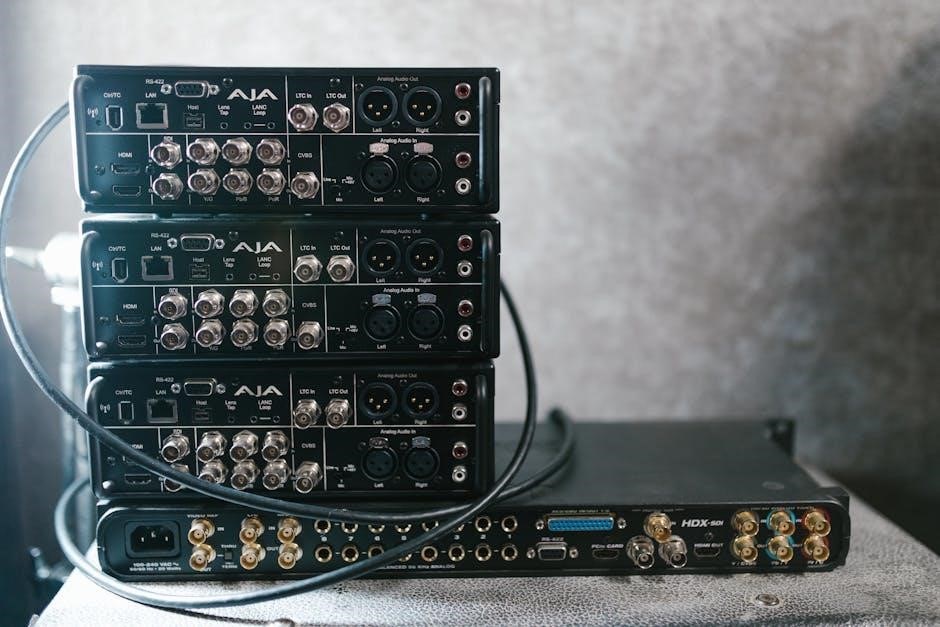
Wiring Diagrams and Visual Guides
Wiring diagrams and visual guides simplify the installation process of 4-way switches. They provide step-by-step instructions and visual representations, ensuring accurate connections and safe setups. Essential for both professionals and DIYers, these resources help avoid common mistakes and ensure compliance with electrical standards. Detailed PDF guides and online tutorials offer comprehensive overviews, making complex wiring configurations more accessible. These tools are indispensable for achieving a reliable and efficient wiring system.
5.1 Standard 4-Way Switch Wiring Diagrams
Standard 4-way switch wiring diagrams illustrate the basic configuration for controlling multiple lights from three or more locations. These diagrams typically include two 3-way switches and one 4-way switch, with traveler wires connecting the switches. The common wire from the power source is connected to one of the 3-way switches, while the neutral wire is connected directly to the light fixture. The diagrams provide clear visual guidance, ensuring proper connections and safe installation. They are essential for understanding how power flows through the circuit and how the switches interact to control the lighting system effectively.
5.2 Wiring Diagrams with Multiple Lights
Wiring diagrams for 4-way switches with multiple lights provide detailed layouts for controlling several fixtures from different locations. These diagrams show how to connect traveler wires between switches and distribute power to multiple lights. The common wire from the power source is linked to one switch, while the neutral wire connects directly to the lights. The diagrams clarify how to wire each light fixture in parallel, ensuring all lights operate simultaneously. This setup allows for flexible control and even distribution of power, making it ideal for larger spaces with multiple lighting points.
5.3 Diagrams for 4-Way Switch with Dimmers
Diagrams for 4-way switches with dimmers illustrate how to integrate dimming functionality into multi-location lighting control. These wiring layouts show the dimmer switch connected in place of a standard 4-way switch, with traveler wires linking the dimmer to other switches. The neutral wire must be connected to both the dimmer and the light fixture to ensure proper dimming operation. The diagrams emphasize the importance of correct wire connections to avoid flickering or malfunctioning lights. They also highlight compatible dimmer types for different lighting setups, ensuring smooth control and energy efficiency.
5.4 Visual Guide for 4-Way Switch Installation
A visual guide for 4-way switch installation provides step-by-step diagrams that illustrate the wiring process. These diagrams show the placement of switches, lights, and wires, making it easier to understand connections. Color-coded wires are highlighted to distinguish traveler, common, and neutral wires. The guide includes images of terminal connections and wiring configurations for different setups, such as multiple lights or dimmer integration. It also shows how to secure wires and mount switches properly. These visuals simplify the process, reducing confusion and ensuring a safe, accurate installation.
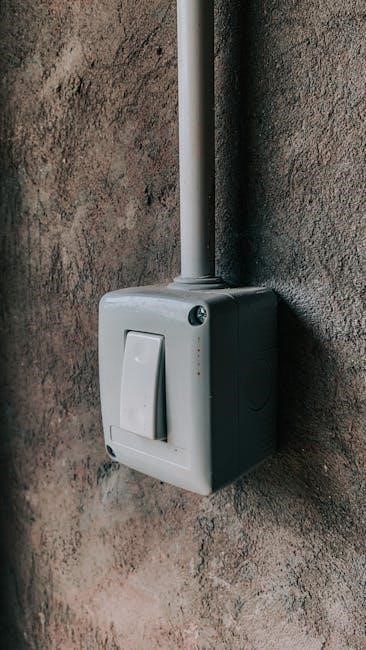
Troubleshooting Common Issues
Troubleshooting 4-way switch issues involves identifying faulty connections, testing circuits, and verifying wire configurations. Common problems include incorrect traveler wire setup or loose terminal connections.
6.1 Identifying and Fixing Short Circuits
A short circuit in a 4-way switch setup can cause lights to flicker or circuits to trip. To identify, turn off power and use a multimeter to test for unintended connections.
Inspect wires for damage or improper connections, especially at terminals. Fix by repairing or replacing damaged wires and ensuring all connections are secure.
Verify that traveler and common wires are correctly configured. If issues persist, consult a wiring diagram to trace connections accurately and safely.
6.2 Resolving Issues with Traveler Wires
Traveler wires are critical in 4-way switch circuits, as they connect the switches and lights. Common issues include incorrect connections or loose wiring.
To resolve, turn off power and verify the wiring diagram. Ensure traveler wires are connected between the two 4-way switches, not to the light or power source.
Check for loose terminals and tighten them. If wires are crossed or misconnected, reconfigure them according to the diagram. Proper installation ensures smooth operation of the circuit.
6.3 Checking for Loose Connections
Loose connections are a common cause of malfunctions in 4-way switch circuits. Always turn off the power and use a voltage tester to ensure safety.
Inspect all wire terminals and connections to the switch and lights. Tighten any loose screws or clips using a wrench or screwdriver.
Look for signs of wear, such as frayed wires or corroded terminals, and replace them if necessary. Properly securing connections ensures reliable operation.
Even minor looseness can disrupt the circuit, so double-check every connection before restoring power. This step is vital for maintaining functionality and safety.
6.4 Diagnosing Neutral Wire Problems
Neutral wire issues can cause lighting circuits to malfunction. Start by verifying the neutral wire is properly connected to the circuit. Use a voltage tester to ensure the neutral wire has no power when the circuit is off. Check for loose or incorrect connections at the switch, lights, or junction boxes. If the neutral wire is shared among multiple circuits, ensure it’s not overloaded. Consult the wiring diagram to confirm the neutral path is correctly routed. Repairing neutral wire problems often resolves flickering or non-working lights, ensuring safe and reliable operation.
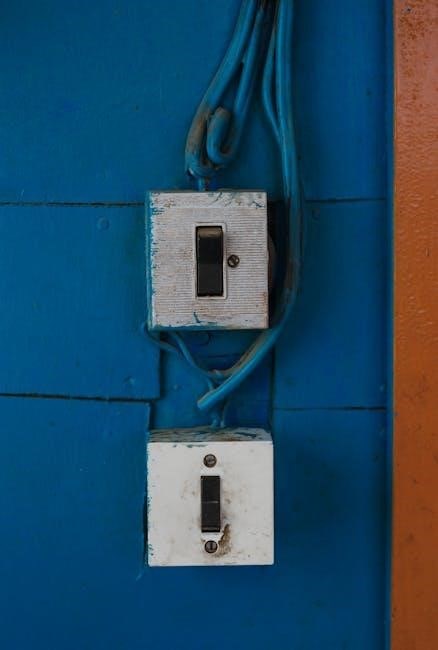
Best Practices for 4-Way Switch Wiring
Adhere to best practices by using correct wire gauges, labeling all wires and terminals clearly, ensuring secure connections, and testing circuits thoroughly before finalizing.
7.1 Using the Correct Wire Gauge
Using the correct wire gauge is essential for safe and efficient 4-way switch wiring. Typically, 14 AWG or 12 AWG copper wires are recommended for residential applications. Thicker wires (lower gauge numbers) can handle more current, reducing the risk of overheating. Always match the wire gauge to the circuit’s current rating and voltage requirements. Using the wrong gauge can lead to electrical hazards or malfunctioning switches. Consult local electrical codes or a licensed electrician to ensure compliance with safety standards and optimal performance for your 4-way switch configuration.
7.2 Properly Labeling Wires and Terminals
Properly labeling wires and terminals is critical for clarity and safety in 4-way switch wiring. Use a label maker to mark wires with their purpose (e.g., “traveler” or “common”) and their destination. Labeling terminals on the switch ensures correct connections and simplifies future maintenance. Color-coding wires (e.g., black for hot, white for neutral) further enhances organization. Clear labels prevent confusion and reduce the risk of electrical errors. Consistent labeling across all components guarantees a systematic and professional installation, making troubleshooting easier and safer over time.
7.3 Ensuring Secure Wire Connections
Ensuring secure wire connections is vital for reliable 4-way switch operation. Always use appropriate connectors like wire nuts or screw terminals to prevent loose connections. Tighten all terminal screws firmly, but avoid over-tightening, which can damage wires. Double-check connections to ensure wires are seated correctly and not twisted together. Use electrical tape or heat shrink tubing to insulate exposed wire ends. Test each connection with a voltage tester to confirm proper contact. Secure connections prevent arcing, short circuits, and potential fires. Regularly inspect and tighten connections over time to maintain safety and functionality.
7.4 Testing the Circuit Before Finalizing
Testing the circuit before finalizing ensures functionality and safety. Use a voltage tester to verify live wires are properly connected. Turn the power on and test each switch position to confirm all lights or devices operate correctly. Check for short circuits by ensuring no unexpected power is present. Verify neutral wires are securely connected and not carrying voltage. After testing, reboot the circuit breaker and flip switches multiple times to ensure consistent operation. This step guarantees the wiring is safe, reliable, and functions as intended, preventing future issues.
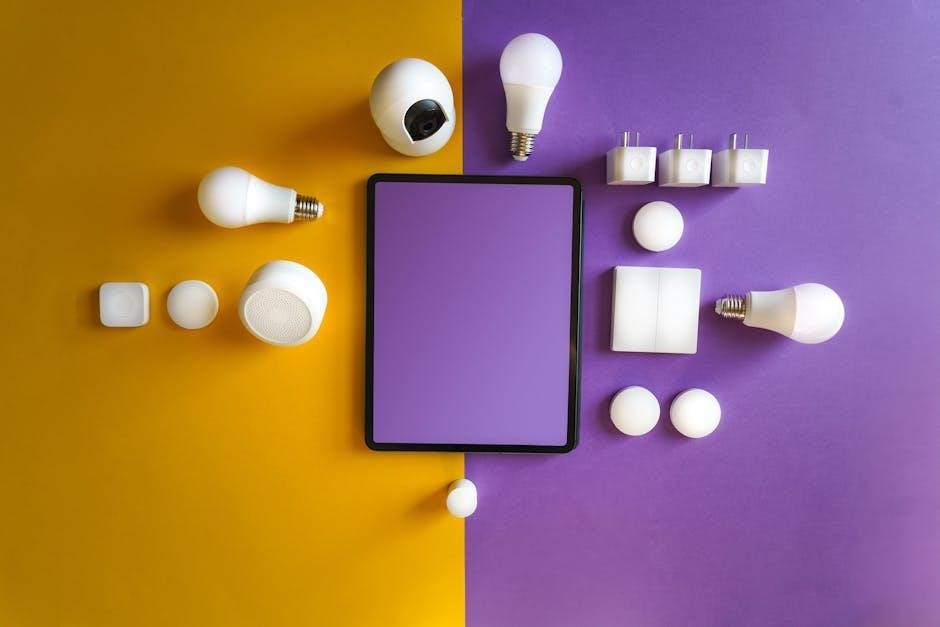
Advanced Configurations and Variations
Explore advanced setups, including multiple control points, dimmer integration, and smart switch compatibility, to enhance functionality and customization in complex lighting systems.
8.1 Wiring a 4-Way Switch with Multiple Control Points
Wiring a 4-way switch with multiple control points allows for enhanced flexibility in lighting control. This configuration typically involves more than two switches controlling the same light fixture. The key is to ensure proper connections between the traveler wires, which carry the electrical signal between switches. Each additional control point introduces complexity, requiring careful planning and precise wiring. Use a detailed wiring diagram to map out connections, ensuring all terminals are correctly linked. Properly gauge the wire size and maintain secure connections to prevent issues. Regular testing and inspection are crucial to ensure reliable operation across all control points.
8.2 Integrating Dimmers and Smart Switches
Integrating dimmers and smart switches into a 4-way switch configuration enhances lighting control and energy efficiency. Dimmers require specific wiring for load and line connections, while smart switches often need additional wires for features like Wi-Fi or voice control. Ensure compatibility between dimmers and LED fixtures to avoid flickering or reduced lifespan. Smart switches can be programmed for scenes or schedules, adding convenience. Always consult the manufacturer’s guide for compatible configurations. Proper wiring sequence and secure connections are critical to avoid malfunctions. Testing the system thoroughly ensures smooth operation and optimal performance.
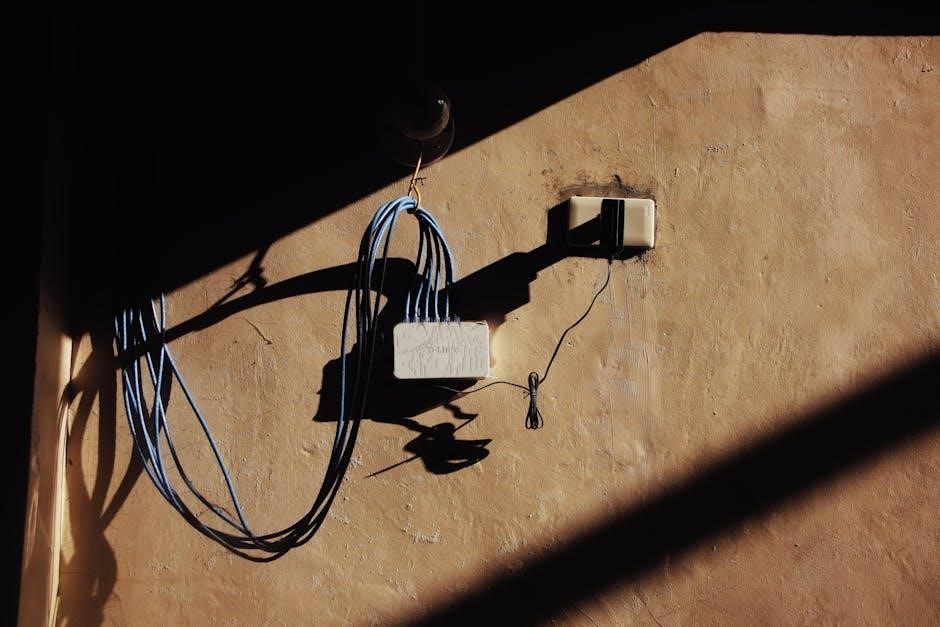
8.3 Configuring for LED Lighting Systems
Configuring a 4-way switch for LED lighting systems requires careful consideration of compatibility and energy efficiency. LEDs operate on low voltage and require minimal current, making them ideal for modern setups. Ensure the switch and wiring are rated for LED loads to prevent overheating. A neutral wire is often necessary for proper LED operation. Connect the LED driver or module according to the manufacturer’s instructions. Verify the total load does not exceed the switch’s capacity. Proper grounding and secure connections are essential to avoid flickering or premature failure. Always test the system to ensure smooth dimming and reliable performance.
8.4 Wiring for High-Voltage Applications
Wiring a 4-way switch for high-voltage applications demands specialized attention to safety and component ratings. High-voltage systems often require heavier-gauge wires to handle increased current loads. Ensure all components, including switches and wires, are rated for the specified voltage to prevent damage or hazards. Thermal management is critical; consider heat sinks or ventilation to maintain safe operating temperatures. Proper insulation and surge protection are essential to protect against voltage spikes; Always verify local electrical codes and consult professional guidelines for high-voltage installations. Testing the system under controlled conditions before full operation is highly recommended to ensure reliability and safety.

Resources and Tools for 4-Way Switch Wiring
Essential tools include wire strippers, multimeters, and needlenose pliers. Resources like official 4-way switch wiring diagrams, video tutorials, and electrical safety handbooks are invaluable for successful installations.
9.1 Recommended Tools for Wiring
For wiring a 4-way switch, essential tools include wire strippers, needlenose pliers, screwdrivers, and a multimeter. Wire strippers are used to remove insulation, while pliers assist in bending and gripping wires. Screwdrivers are necessary for securing connections. A multimeter helps verify voltage and ensure safety. Additionally, a voltage tester is crucial for checking live wires before work. These tools ensure accurate and safe wiring, especially when following a 4-way switch wiring diagram PDF. Proper tools prevent errors and enhance efficiency during installation.
9.2 Free PDF Guides and Manuals
Free PDF guides and manuals for 4-way switch wiring are widely available online, offering detailed diagrams and step-by-step instructions. These resources are ideal for professionals and DIY enthusiasts, providing clear visual representations of wiring configurations. Many PDFs include safety tips and troubleshooting advice. They often cover various setups, such as multiple light controls and dimmer integrations. Users can download these guides from reputable websites or electrical forums. Ensure the source is reliable for accurate information. These manuals are invaluable for understanding and executing 4-way switch wiring safely and efficiently, making them a must-have for any electrical project.
9.3 Online Tutorials and Video Guides
Online tutorials and video guides provide hands-on instruction for wiring 4-way switches, often accompanied by detailed diagrams. Platforms like YouTube and electrical forums host numerous step-by-step videos. These resources cover topics such as installation, troubleshooting, and advanced configurations. Many tutorials include real-time demonstrations, making complex wiring easier to understand. They also offer tips for safety and best practices. Whether you’re a professional or a DIY enthusiast, these visual guides are invaluable for mastering 4-way switch wiring. They often include interactive Q&A sections and downloadable resources for further learning, ensuring a comprehensive understanding of the process.
9.4 Electrical Safety Handbooks
Electrical safety handbooks are essential resources for ensuring safe practices when wiring 4-way switches. These handbooks provide detailed guidelines for handling electrical systems, including proper use of tools, protective equipment, and safety protocols. They often include sections on circuit analysis, voltage testing, and emergency procedures. Many handbooks are tailored for DIY enthusiasts and professionals alike, offering clear instructions to prevent accidents. By following the principles outlined in these handbooks, individuals can minimize risks and ensure compliance with electrical codes. They are a critical companion to wiring diagrams, emphasizing safety above all else.
10.1 Summary of Key Takeaways
Understanding 4-way switch wiring diagrams is crucial for controlling multiple lights from different locations. Properly identifying terminals, using correct wire gauges, and following safety protocols ensure reliable connections. Always label wires and test circuits before finalizing. Consulting resources like PDF guides and diagrams helps avoid common errors. Troubleshooting issues promptly prevents hazards. By adhering to best practices, you can achieve efficient and safe wiring configurations, enhancing your electrical system’s performance and longevity.
10.2 Encouragement for Safe and Accurate Wiring
Always prioritize safety and precision when working with 4-way switch wiring diagrams. Take your time to review diagrams and plan carefully to avoid errors. Remember, patience ensures a reliable and hazard-free electrical system. Double-check connections and use proper tools to maintain accuracy. The satisfaction of a successful installation comes from attention to detail and adherence to safety guidelines. Stay confident, follow best practices, and consult resources like PDF guides to achieve professional-grade results. Safe wiring not only protects you but also enhances the functionality and longevity of your electrical setup.
